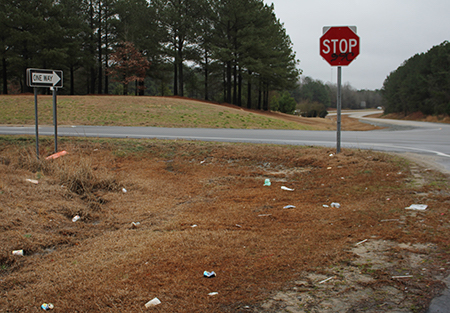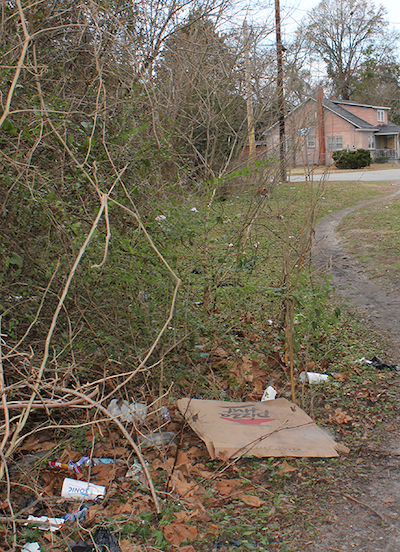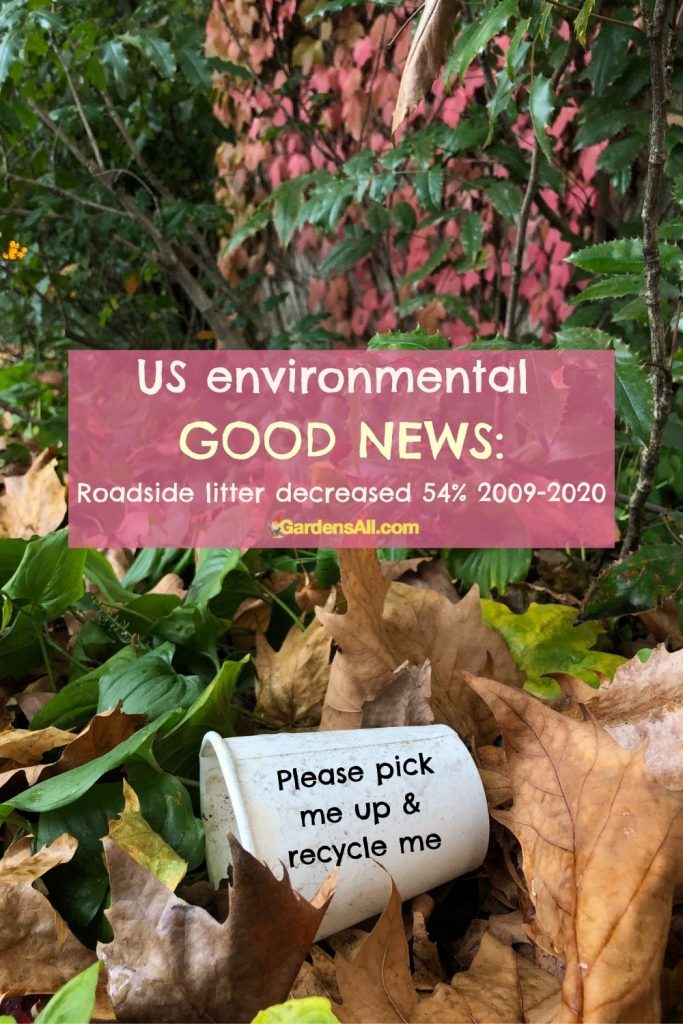Litterbugs Definition: One who litters in a public area. Also called litter bugs, but usually as a compound word that combines the two. Either way, it means the same thing in the USA. In the UK, the term is litter lout.
Wow!… Litterbugs should be extinct by now, right?! Yet here in 2022, there are still people who toss trash to the ground without a second thought.
Walking in our rural neighborhood, and beyond, we need to travel with a bag for picking up litter left by kids and tossed out of passing cars.
When I was growing up in the 60’s, many people from all walks of life would toss trash out of the car window without giving it a second thought.
Now, most of us are not litterbugs and are more aware of taking care of this precious Earth. Certainly, we would never even consider littering by throwing the piece of trash in our hand onto the ground or out the car window.
We’ve seen some who empty the ashtray of their car out onto the ground in a parking lot. So yes… litterbugs still exist.
In this Covid era, you might imagine some of the most common litter found on roadways and waterways. Still… we’ve come a long way, so let’s celebrate the gains and work on closing the gaps.
We’ve come a long way… and we still have a ways to go in consciousness and awareness.

We Can’t Change the World – So We Change Our Focus
We cannot fathom even thinking of littering, let alone doing so. Likely that’s true for you too if you’re taking the time to read this.
However, lamenting and complaining about what others are or are not doing is a waste of time and energy.
What We Can Do
Whenever we see something that irritates us, such as a litterbug or wastefulness in another, we no longer waste our time and energy giving it a second thought. Why litter our day with negativity?!
So rather than littering the day with negative thoughts, irritations and anger, we look at what we can improve within ourselves and our own life.
So if waste or thoughtlessness in another is bugging us, we look at where and what we may be doing that is wasteful or thoughtless. There’s always some area to improve. We use that energy to clean up something in our own life, including our thoughts!
More often than not, it’s easy to find something to improve that we hadn’t thought about, such as conserving and reusing, upcycling and recycling more items.
For example, many health-conscious people may drink bottled water, and yet one of the biggest disposables in the world is…. you guessed it, plastic water bottles. A simple shift to reusable water bottles can make a big difference.
In our rural setting, we have good well water, so we don’t need to buy water, but that can be harder for city dwellers. In that case, water filters are beneficial and filtering pitchers. Contracting with the large water bottle exchange programs can be a beneficial solution as well.
One of the biggest disposables in the world is empty bottled water bottles.
The Cost of Litterbugs
How much is litter costing us as taxpayers, (businesses and individuals alike)?
- In 2008 US businesses and taxpayers spent nearly $11 billion on litter clean-up across the U.S., 10x more than the cost of trash disposal.
- The NC DOT spent over $16 million in 2016 to remove approximately 7 million pounds of roadside litter.
- In 2010, the estimated cost of litter pickup is 30 cents per piece of litter.
- One mile of highway contains approximately 16,000 pieces of litter.
- Thousands of litter-related accidents occur, with life and property losses, and cause insurance rates to rise.
- $90 million worth of cans, bottles and newspapers in a landfill would be valued at $300 million if those items were recycled!!![1]https://www.ncdps.gov/news/news-release/2016/04/14/highway-patrol-and-ncdot-team-%E2%80%9Cspring-litter-sweep%E2%80%9D
- Litter reduces property values.
- Tourism declines when vistas are spoiled by litter[2]https://www.ncdps.gov/dps-services/crime-prevention/litter-free-nc/litter-facts
$90 million worth of cans, bottles and newspapers in a landfill would be valued at $300 million if those items were recycled!!
SOURCE: NC Dept. of Public Safety
67% of litter in commercial streets is comprised of single use disposable food and beverage packaging.[3]https://cleanwater.org/rethinkdisposablenj/theproblem
SOURCE: 2011 Clean Water Action study CleanWaterAction.org

Primary Sources of Litter
This first list is in alphabetical order and those items bolded have increased in quantities between 2009 and 2020, whereas all of the other categories have decreased since the 2009 study.
Types of Litter – listed alphabetically
- Beer containers
- Cardboard
- Cigarette butts – decreased from 18.6 billion in 2009 to 5.7 billion cigarette butts in 2020
- Personal Protective Equipment (PPE), Covid-19 related litter, such as masks and gloves at 207.1M with 127.4 million pieces of that was along U.S. waterways.
- Fast food
- Food-packaging film
- Sports drinks containers
- Unsecured truck bed loads
- Water containers
SOURCE: Keep America Beautiful 2020 NATIONAL LITTER STUDY Summary Report: May 2021[4]https://kab.org/wp-content/uploads/2021/05/Litter-Study-Summary-Report-May-2021_final_05172021.pdf
Percentage by Type of Litter in the US in a 2020 Study
- 90% of litter was under 4 inches in size
- 38.6% of litter was made from plastic
- 19.6% cigarette butts – while these are still high, it’s down 70% from 2009!!!
- 15.2% was paper litter
- 7.9% metal littler
- 7.2% glass litter
- 2.6% organic matter
SOURCE: Keep America Beautiful 2020 NATIONAL LITTER STUDY Summary Report: May 2021[5]https://kab.org/wp-content/uploads/2021/05/Litter-Study-Summary-Report-May-2021_final_05172021.pdf
Trucks With Unsecured Loads
Don’t contribute to litter. It could mean a ticket for you—or worse—accidents and harm to others! We’ve done an article and short video showing you our favorite and most effective and easy truck bed tie downs for securing cargo.
You can download a free Tarp Awareness Brochure here.[6]https://www.ncdps.gov/document/tarp-awareness

Our Super Simple System for Securing Cargo
Read the article, see photos and watch the short video clip on Coleman’s unusual truck bed tie-downs that are super simple and effective.
For North Carolinians (check your state for something similar), a number to place in your cell phone Favorites for speed dialing will connect you with non-emergency state trooper support, including reporting of unsecured loads:
To report unsecured loads and other non-emergency state trooper support, motorists may dial *47 or *HP on a cellular phone.
By placing that number in your speed dial on your cell phone so that you may more safely dial while driving if you see an issue or potentially hazardous unsecured cargo, you could even be saving a life. Think of those cars driving at highway speeds who suddenly encounter a large object in the road. Or worse… those vehicles that get hit by falling debris.
Taking action is simple and could save lives!
These ladies each had an angel on her shoulder, for they all survive this falling projectile![7]https://wwlp.com/2015/11/04/piece-of-lumber-came-crashing-through-windshield/


Cigarettes Are a Big Litter Problem for Such a Small Item
In 2020, cigarette butts make up 19.6% of existing litter, take 12 years to break down, and leak cadmium, lead and arsenic into soil and waterways.
The good news is that cigarette butt litter along roads has decreased from 18.6 billion cigarette butts in 2009 (!!!) to 5.7 billion cigarette butts in 2020. Great news… let’s keep on improving that because that’s still a huge number considering issues they can cause.
Problems With Cigarette Butt Litter
- Take 12 years to break down and leak cadmium, lead and arsenic into soil and waterways.
- Can poison children or animals who may find and eat them.
- Accumulate outside of buildings, on parking lots or streets are washed through storm drains and into city water systems, streams, rivers, and beaches.
- Lit cigarettes thrown from car windows can cause forest fires.
The Costs of Litterbugs
It’s sobering to consider for a moment, just how much trash costs all of us, for we taxpayers fund some of this clean-up.
Litter clean up costs the U.S. more than an estimated $11.5 billion each year.
Entity
Costs in US $
- States
- Counties
- Municipalities
- Businesses
- Educational
- NGOs
- 363 million
- 185 million
- 797 million
- 9.1 billion
- 240 million
- 769 million
Neighborhood Impact of Litterbugs
Heavily littered neighborhoods experience more vandalism and other crimes, as well as reduced real estate prices.
- 93% of homeowners believe a littered neighborhood would influence their buying decision
- 40% estimated that litter would reduce a home’s value by 10% to 24%.
- 36% of business development officials say that litter impacts a decision to locate to a community.
- 55% of realtors think that litter reduces property values by about 9%.
- 60% of property appraisers would reduce a home’s value if it was littered.
REFERENCE: The 2009 National Visible Litter Survey and Litter Cost Study was prepared by MidAtlantic Solid Waste Consultants for Keep America Beautiful, Inc[8]https://kab.org/wp-content/uploads/2019/08/News-Info_Research_2009_NationalVisibleLitterSurveyandCostStudy_Final.pdf

The Good News – the Litter Problem is Getting Better
- 61% decrease in visible roadway litter between since 1969 and 2009
- 54% decrease in roadside litter in the USA between 2009-2019
- 2009 – an estimated 51.2 billion pieces of litter were cleaned up along US roadways. The Keep America Beautiful
- 2020 – approximately 23.7 billion pieces of litter were found along United States roadways in 2020.
- Decrease in high-profile litter categories such as:
- cigarette butts – 70 percent decrease in cigarette butt litter in 2020 vs. 2009
- fast food and soft drink containers
- saw large decreases in the number of littered items
SOURCE: Keep America Beautiful 2020 NATIONAL LITTER STUDY Summary Report: May 2021[9]https://kab.org/wp-content/uploads/2021/05/Litter-Study-Summary-Report-May-2021_final_05172021.pdf
So we are making progress!!!
It’s also good news that many more people are getting into gardening these days from a desire toward greater self sufficiency, cutting down on food costs, healthier food, and also for the many garden therapy benefits!
So let’s keep on growing and planting our own food — including edible flowers! — and medicinal and antifungal herbs and plants.
We can create beautiful and edible landscape, aka foodscapes, with pollinator flowers, while reusing, recycling and upcycling whatever we can, including any negative thoughts or irritations for they don’t serve us! Let’s compost those into positive energy by focusing on what’s right rather than on what’s wrong, and grow something better with them! 😇
In the garden, we use the manure to help things grow. But we don’t focus on it! Instead, we focus on what we want, not what we don’t want, and so that is what grows. It’s the same with our life.! 👩🏻🌾🌹👨🏻🌾
What you focus on grows in the garden of your life.
~LeAura Alderson, creator, iCreateDaily.com
US environmental GOOD NEWS: Roadside litter decreased 54% 2009-2020

How to Make a Difference
The first and most important way we can make a difference is to focus on the good things in life and on gratitude, for there are so many blessings in each day. And… we can:
- Focus on the positives
- Cultivate our yard and garden with beautiful and edible plants and herbs
- Always dispose of our own trash responsibly:
- trash cans
- recycle
- repurpose
- reuse
- upcycle
- Pick up trash when we we see it
- Be hopeful and optimistic
How to Report Litterbugs
Our state of North Carolina has a way to report a litterbug. We don’t know how effective any of that is, but if you’re so inclined, you can look into this for your state. In NC it’s called “Swat-a-litterbug”.
It’s always good to have a sense of humor! 😇

- Use the Swat-A-Litterbug form on the Dept. of Transportation’s website.
- Call *HP to notify the State Highway Patrol if you see someone littering.
We are an online gardening publication sharing all things garden related! Including urban farming, family gardening, homesteading, gardening for profits, and more. We’re all about growth!
References

